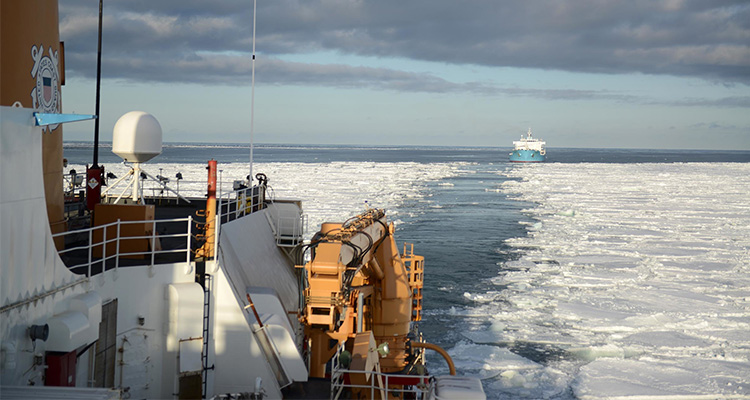By: The National Academies Staff
The National Academies of Sciences, Engineering, and Medicine Committee on Polar Icebreaker Cost Assessment released a report in July that advises the U.S. Congress on strategies to minimize life-cycle costs of polar icebreaker acquisition and operations.
A U.S. presence in the high-latitude regions requires reliable year-round access in order to support economic interests, search-and-rescue needs, defense and security readiness, environmental protection, maritime mobility, and scientific research. In the Antarctic, the U.S. maintains three year-round research facilities and verifies compliance with international treaty obligations, both of which require icebreaking ability during any season.
The U.S. Coast Guard (USCG) currently has three multi-mission polar icebreakers in its inventory: the USCG Cutter Polar Star, the USCG Cutter Polar Sea, and the USCG Cutter Healy. However, the Polar Sea was removed from service in 2011 after a major engine casualty in 2010 and is being used for parts. Only the Polar Star— built in 1976 and nearing the end of its useful life in the next three to seven years—is capable of independently performing the annual breakout and resupply of McMurdo Station in the Antarctic.
The report states that four heavy icebreakers would allow the USCG to meet its statutory mission needs at a lower cost, and would provide three ships for a continuous presence in the Arctic and one ship to service the Antarctic.
The committee recommended an acquisition strategy that includes block buy contracting with a fixed-price incentive fee contract to ensure the best value for investment of public funds. By taking advantage of the approach outlined in the report and based on the acquisition of four ships of common design, the average cost per heavy icebreaker is estimated to be $791 million. Four heavy icebreakers of common design will reduce operating and maintenance costs over the life of the vessels, improve continuity of service, increase USCG's icebreaking capability, and improve operational effectiveness.
The report also states that the USCG should ensure that the new icebreakers are "science-ready," and one should have full science capability to be used as a replacement for the Healy as it is approaching the end of its life. Including science readiness in the design is a more cost-effective way to fulfill both the USCG polar missions and the nation's future polar research needs. Science-ready design includes several critical elements that cannot be retrofitted cost-effectively into an existing ship, such as flexible accommodation spaces and weight and stability latitudes to allow installation of scientific equipment. A fully science-capable ship would include features such as oceanographic over-boarding handling equipment and ship-supplied instrumentation and facilities comparable to other modern oceanographic research vessels. Given the pivotal role of polar oceans in global circulation and Earth and ecosystem processes, and their national security importance, maintaining U.S. polar oceanographic research capability is vital for the nation, the report says.
The report is mandated by the Coast Guard Authorization Act of 2015 and sponsored by the USCG. Additional information and a copy of the report can be found on the Transportation Research Board webpage.

